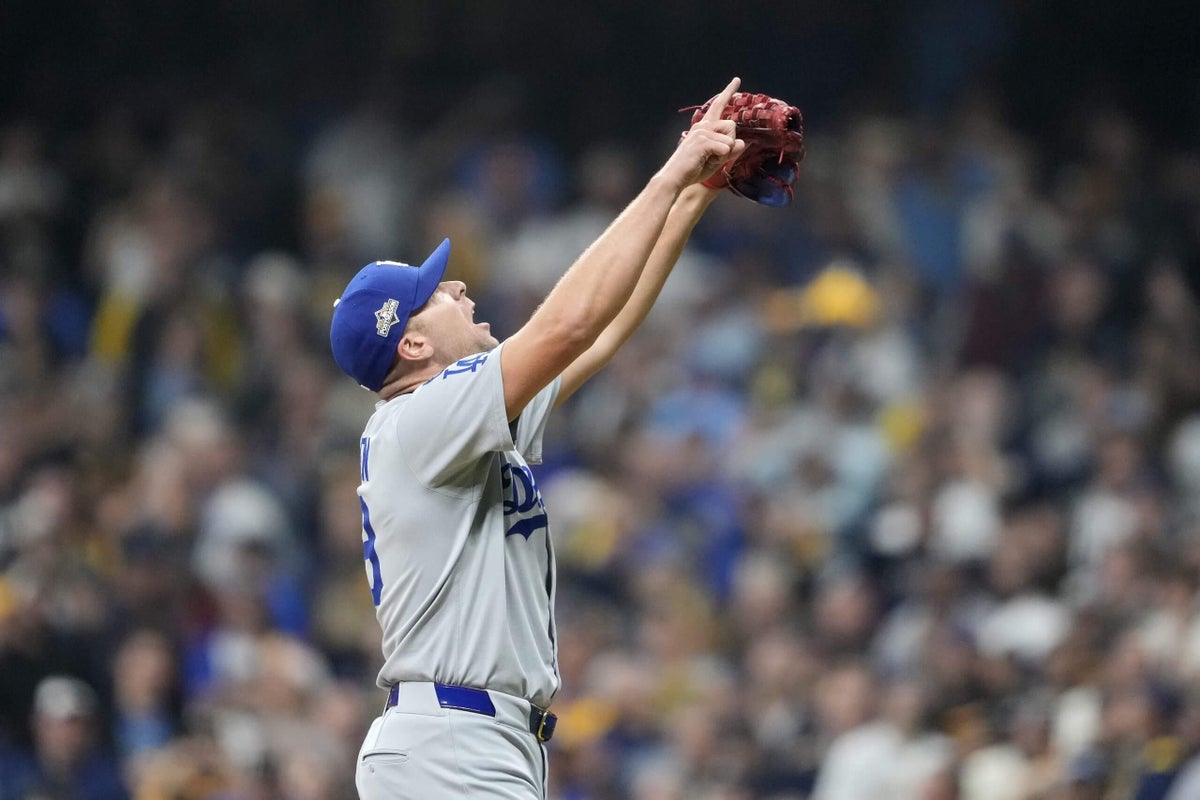MILWAUKEE — With the biggest pitch of the ballgame looming, Blake Treinen toed the rubber, exhaled and reared back to deliver what he hoped would be a game-ending fastball.
Out of hand, he knew he’d missed his spot. But Treinen’s initial frustration gave way to relief when Brice Turang chased above the zone for strike three, stranding the Brewers’ tying run 90 feet from home and saving the Los Angeles Dodgers from disaster with a 2-1 win over the Milwaukee Brewers in Game 1 of the National League Championship Series on Monday.
Trienen spun, roared and pumped his fists. Turang paused in the batter’s box and dropped his head back in agony. Somehow, a Dodgers bullpen riddled with questions and running low on options, eked out another save. This time it came via the hands of Treinen, an experienced but struggling arm well aware of the narrative surrounding him and the rest of the Dodgers’ relievers this October.
For weeks, Los Angeles has tried to patch together a bullpen dismantled by injuries and poor performance. The Dodgers have flirted with danger while losing just one game this postseason. But concerns over the sustainability of the Dodgers’ relief corps linger. In Game 1, it almost cost them dearly.
Victory formation! #NLCS pic.twitter.com/DXEIMgRiV2
— Los Angeles Dodgers (@Dodgers) October 14, 2025
Much like Roki Sasaki before him, Treinen did not come out firing. He established a 1-2 count on William Contreras, but then missed on three consecutive pitches to walk him and load the bases. The Brewers, known for their relentless approach, patient at-bats and never-say-die attitude, could feel their momentum peaking. Luckily for Los Angeles, Treinen’s high heater (though misplaced) to Turang was effective. The Dodgers held on. Not much felt safe about it.
“You’ve got to give credit to those guys,” Dodgers manager Dave Roberts said after the win. “They took the walks. They kept the line moving. And ultimately, we had to put the ball over the plate. Blake, fortunately, had a good at-bat versus Turang.
“But it’s not going to come easy. This is going to be a grind. It’s going to be tough. And no one expects it (not) to be.”
Another near ninth-inning disaster came close to wasting a spectacular start by Blake Snell. The lefty dominated Milwaukee through eight innings of one-hit ball and set a postseason career-high with 10 strikeouts.
Roberts has been careful not to tab Sasaki as the team’s official closer, but it came as no surprise to see the 23-year-old begin to warm in the top of the ninth, especially with Snell at 103 pitches. Sasaki had given the Dodgers reason for optimism. He had not allowed an earned run over 5 1/3 postseason innings and locked down two saves. Sasaki’s velocity played up in short stints, and he overpowered opponents with a confidence not always seen during his regular-season starts.
That was not the case Monday night, when he pitched for the first time since his three perfect innings in the closeout game against the Philadelphia Phillies on Thursday. That was his first multi-inning relief appearance since converting to the role. Despite three days of rest, Sasaki was not sharp against the Brewers. His velocity was down and his command was erratic. A one-out walk, a double and a sacrifice fly quickly halved the Dodgers’ lead. His second walk of the frame resulted in the hook.
Treinen, who saw his ERA in September spike to 9.64, entered with the game on the line. He got the job done, and that will help both his and Roberts’ confidence.
But the Dodgers’ bullpen is far from secure. Roberts contemplated sending Snell out for the ninth and described the decision as “50-50.” But given that Snell had not pitched into the ninth this year and that he would potentially take his next start on regular rest, Roberts turned toward his most reliable option.
“Roki has been throwing the baseball really well,” Roberts said. “Had a two-run lead. I felt good with Roki there.”
Asked if there might have been some carry-over from that extended outing, Roberts wasn’t sure.
“He had three days off,” Roberts said. “Everything I heard, he felt great, and there were some near-misses. He was off just a little bit.”
Catcher Will Smith acknowledged the difficulties Sasaki faces in navigating a different role while balancing the high demands of postseason baseball. Those are two things Sasaki is learning on the fly in his first year in MLB.
“He was kind of thrown into the fire,” Smith said. “Probably a little tired. I’m sure he’s not going to admit that, but it wears on you. The mental stress of the playoffs wears on you, the travel wears on you, and the physical aspect wears on you. Dealing with that, I still thought he looked pretty good.”
It would be unfair to say the Dodgers’ bullpen success hinges entirely on Sasaki, but it’s clear he’s their best option in save situations. Alex Vesia, though shaky this October, has been their most trusted left-handed option and Emmet Sheehan is someone the Dodgers hope can be a weapon in relief. Even with his inconsistencies as of late, Roberts still turned to Treinen in the hottest of spots.
“Dave and I have worked together for six years now,” Treinen said. “He’s seen me at my best and my worst. So when he calls my name, I’m grateful he has confidence in me. And I have confidence he’s putting me in situations for the team to win.”
Roberts doesn’t really have any other choice. The Dodgers have played well enough to keep advancing — and that’s all that matters in October. Still, it’s hard to ignore the lingering concern over how they will close out games, especially as they weigh how best (and how often) to throw Sasaki. Their tightrope act worked once more Monday night.
But the longer a best-of-seven series continues, the more difficult it is to balance.
First Appeared on
Source link













